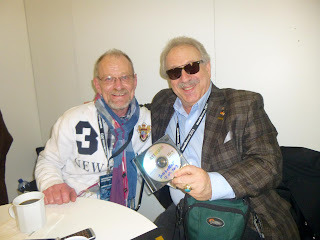#CMinor
Text
Wolfgang Amadeus Mozart Quintet In C Minor For Strings K.406 (1951)

Publication date 1951
Budapest String Quartet
Milton Katims, viola
The Quintet in C Minor for Strings K.406, composed by the genius Wolfgang Amadeus Mozart, stands as a testament to his remarkable talent and mastery of classical music. This quintet, written for two violins, two violas, and cello, showcases Mozart's ability to evoke profound emotions through his intricate composition.
Mozart composed the Quintet in C Minor for Strings K.406 in 1787, during a period of great creativity and productivity in his life. This piece was written during his time in Vienna, where he was well-established as a gifted composer and performer. The composition of this quintet coincided with the premiere of his opera "Don Giovanni," which demonstrates the breadth of Mozart's artistic output during this productive period.
The quintet follows the traditional four-movement structure commonly found in classical chamber music. The first movement, marked Allegro, introduces the main thematic material, skillfully weaving together contrasting melodies and harmonies. This movement showcases Mozart's ability to create tension and drama through dynamic shifts and intricate counterpoint.
The second movement, marked Andante, offers a contrasting mood of introspection and lyrical beauty. Here, Mozart's gift for melodic invention shines through, as the strings engage in a delicate and heartfelt dialogue. The movement unfolds with elegance and grace, captivating listeners with its emotional depth.
The third movement, marked Menuetto, is a delightful and lively dance-like movement. Mozart infuses this movement with his signature charm and wit, showcasing his ability to create music that is both sophisticated and accessible. The interplay between the instruments creates a sense of joyful conversation, with moments of playful syncopation and rhythmic drive.
The final movement, marked Allegro, brings the quintet to a thrilling and exhilarating conclusion. Mozart's masterful use of counterpoint and virtuosic passages creates a sense of urgency and excitement. The movement showcases the technical prowess of the musicians as they navigate through intricate passages, building towards a powerful and climactic finale.
The Quintet in C Minor for Strings K.406 is a masterwork that explores a wide range of emotions and musical techniques. Mozart's use of chromaticism, unexpected harmonic progressions, and expressive melodies creates a rich tapestry of musical colors and textures. The interplay between the instruments highlights the unique qualities of each, allowing the individual voices to blend and soar together in harmonious unity.
Wolfgang Amadeus Mozart's Quintet in C Minor for Strings K.406 stands as a testament to his genius and enduring legacy. Through its four movements, this quintet takes listeners on a journey of emotional depth and musical brilliance. The interplay between the instruments, the intricate composition, and the profound beauty of Mozart's melodies all contribute to the enduring appeal of this masterpiece. The Quintet in C Minor for Strings K.406 remains a testament to Mozart's unparalleled ability to touch the hearts and souls of listeners, even centuries after its composition.
#Mozart#ClassicalMusic#MusicComposition#Quintet#CMinor#StringInstruments#ChamberMusic#MusicHistory#ClassicalEra#Composers
0 notes
Text
Master Yoda composes Piano Concerto No. 2 in C minor, Op. 18 with Rachmaninoff
Master Yoda: Greetings, Rachmaninoff. I sense the struggle within you. May the Force guide us in your composition of Piano Concerto No. 2 in C minor, Op. 18.
Rachmaninoff: Thank you, Master Yoda. I have been struggling with the development section of the first movement. I cannot seem to find the right chords.
Master Yoda: Ah, the development section. A crucial component of a concerto. Remember,…

View On WordPress
#chords#circleoffifths#ClassicalMusic#Cminor#creativity#developmentsection#guidance#harmonization#JediKnight#MasterYoda#musiccomposition#Op18#pianoconcerto#Rachmaninoff#sonataform#StarWars#TheForce#thememelody#wisdom
1 note
·
View note
Text
daily violin affirmation: I can be normal about cminor in third position, I do not hold any deep grudges toward the fourth finger in cminor third position, I never forget to play the f in cminor third position
11 notes
·
View notes
Text
Jon Hammond's Hammond Report Thing In C minor
#WATCHMOVIE HERE: Jon Hammond's Hammond Report Thing In C minor
Jon's archive https://archive.org/details/jon-hammonds-hammond-report-thing-in-c-minor
Youtube https://youtu.be/F3L7k4ue3ow
FB https://www.facebook.com/558692101/videos/760633772441647/
Jon Hammond's Hammond Report Thing In C Minor
by
Jon Hammond





Usage
Attribution-NonCommercial-NoDerivs 4.0 International




Topics
Hammond Report, C minor, Frankfurt, Organ Combo, Jon Hammond, Hammond Organ
Language
English
Jon Hammond
Giovanni Totò Gulino
Peter Klohmann
Joe Berger
#cminor
#funk
Addeddate
2023-03-23 20:01:19
Identifier
jon-hammonds-hammond-report-thing-in-c-minor

Hammond Report, C minor, Frankfurt, Organ Combo, Jon Hammond, Hammond Organ
Hammond Report, C minor, Frankfurt, Organ Combo, Jon Hammond, Hammond Organ
1 note
·
View note
Text
Writing my own Tracks
I started to work on a main melody around the key of Cminor. I tried to record guitar but I didn't feel that the guitar was best conveying my vision so I switched to the midi synth within logic.
I used my keyboard to play the synth and produced a 2 bar melody around an Am7add11 chord. The first bar alternates between 3 quaver notes A,C,D; creating a catchy riff. The 2nd bar descends and adds a 4th note, G, to vary the pitch dynamics.

To widen the range of pitch used within the track, I wrote and recorded my own ascending bass riff that would compete with the shrill tones of my main melody. I used notes C, Eb and F as part of the Cmadd4 chord.

Additionally I wrote out some chords to stabilise all the melodies that were occurring during SectionA. This was made up of G, Bb and C, part of the Gmadd4 chord.

0 notes
Text

New Concepts for Music And Sound – Part 6
(Excerpt from my e-book about this topic: https://www.dev.rofilm-media.net/node/537)
What the pioneers of electronic music worked on, emphasised more than before or even discovered, and how to translate this to our situation today:
Aspect 3:
The relation of composer, instrumentalist and machine (tape)
The tape plays a pre-recorded piece of music, and the instrumentalists answer in a pre-arranged way (Stockhausen and others). Or the Orchestra plays a composed piece of music, and the tape answers in a pre-arranged way (Xenakis and others). The tape plays a pre-recorded piece of music, and the instrumentalists deliver the answer through improvisations (Stockhausen and others). Alright then, what could be the next step, the next border to be torn down? What if not the musician, the instrumentalist, but the machine improvises? Are “random” and “generative” (what is not at all the same – just by the way) the terms we will have to focus on? I don´t think so. And my denial is not based on the fact, that even generative music and randomness in general are not new any more. If a piece of music played by a human (improvised od composed) is followed by a piece of generative music (or in simpler versions: by randomly occurring sonic events), then this is not at all an answer. We may call it pseudo-improvisation or even “wannabe” improvisation – nothing more. The machine simply plays according to a set of rules which DO NOT (CANNOT) relate to what has been played by the musician before. No, the next step the next crossing of a border is indeed using artificial intelligence, which is able to react to what the musicians hand over. And so in a sequence of human-made music – AI-made music – human-made music etc. we might be able to create something really new.
Aspect 4:
The liberation of music from scales and the organisation of sound itself
Here I´m quite unsure in which direction we could go further to bring something new. Organising timbre, organising sound itself to a musical composition seems to touch the limits of musical possibilities in this direction. To say it in a really simple way: we have already ignored scales. We have already ignored even pitch. And we have organised timbre/sound/spectra. What else is left to do here? Perhaps it´s the return to scales, but on a higher level: to scales of timbres. But is this possible at all? Aren´t there unlimited amounts of different sounds – opposed to the lower (but still high – think of microtonal works) number of distinguishable pitches? And how to respect the dynamics, the changes of the spectra over time which are determiners of a certain sound as well? We have structures of pitches called scales like Cminor, Fmajor etc. But will we be able to organise sound/timbre/spectrum in anything like “green” of “blue” or “dark” or, or, or? And then define the sonic equivalent to a chord progression (I-IV-V-I for example), a specific sound progression? I simply don´t know.
Enjoy your day!
Rolf
… to be continued
https://www.dev.rofilm-media.net/node/537)
0 notes
Text
Watch "DT0041: Just Another Piano Rap Beat (Free)" on YouTube
youtube
#91bpm #piano #cminor #rapbeat #instrumental #2022instrumental
0 notes
Video
youtube
One of my favourite Ciaconna’s from the Baroque era: Buxtehude’s offering in C Minor, with a grandiose pedal part.
#buxtehude#dieterichbuxtehude#ciaconna#organ#cminor#lübeck#marienkirche#organist#composer#dietrichbuxtehude#janreincken
7 notes
·
View notes
Video
Few choruses from Blue Bossa 🎸 #bluesbossa #jazz #jazzmusic #choruses #jazzguitar #guitarofinstagram #instamusic #cminor #friday #standard https://www.instagram.com/p/B2WTrYBjgtL/?igshid=1d06ih55spn4w
1 note
·
View note
Text
2 notes
·
View notes
Audio
The third piece I will share is one I am incredibly surprised not to have shared already. Completed in November 2015, this is my second symphony, and surprisingly the last one I have completed. This is very similar in style to the last piece I shared, though they were composed two years apart, except the final movement, instead of being reminiscent of Mendelssohn and the early Romantics, almost reminds of Brahms 1 or Holst’s Jupiter. As a final moment of composer-like smartarsery, I included references to all 3 previous movements at the end of the fourth movement – as if anyone would hear them over one another. That’s the kind of things composers do, and you’ve got to hate us for it.
@you-had-me-at-e-flat-major
#richardblaquiere#richard#blaquiere#brahms#symphony#no2#cminor#c minor#november#2015#holst#composer#movements#allegromolto#adagio#allegro#composition#orchestra#viola#violin#cello#composing#contemporarymusic#contemporary composer#youngcomposer#artist#art#music#classicalmusic#classical music
49 notes
·
View notes
Video
SoleA. The footage is from my train ride into the city of London. #cminor #thegemstones #goldeneramusic #dopebeats #hiphop #komplete11 #soul #nativeinstruments #maschinemk3 https://www.instagram.com/p/Bq8PcjiFoui/?utm_source=ig_tumblr_share&igshid=kluelkahlp12
2 notes
·
View notes
Video
#TBT Yo-Yo Ma - Bach Cello Suite No 5 in C Minor #Yo-YoMa #JohannSebastianBach #Cello #SuiteNo5 #CMinor #Haji #Blood+ (at Puerto Iguazú) https://www.instagram.com/p/Bnr6oFKnSPs/?utm_source=ig_tumblr_share&igshid=ek17bprpvfbx
1 note
·
View note
Text
Hammond Report November 16 2021 From Pandemic Quarantino Jon Hammond
#WATCHMOVIE HERE: Hammond Report November 16 2021 From Pandemic Quarantino Jon Hammond
Jon's archive https://archive.org/details/hammond-report-november-16-2021-from-pandemic-quarantino-jon-hammond
Youtube https://www.youtube.com/watch?v=_ML3reCkaso
FB https://fb.watch/9kcQH36QKt/
Hammond Report November 16 2021 From Pandemic Quarantino Jon Hammond
by
Jon Hammond




Hammond Report November 16 2021 From Pandemic Quarantino Jon Hammond - Daily Music and Stories from Jon Hammond the organ player & accordionist - today's music story about playing my tune Thing in C minor, the relative key of E flat major - 3 flats, and we play all 3 and then some! On the band at Jazzkeller: Giovanni Totò Gulino. Peter Klohmann. Joe Berger and yours truly Jon Hammond at the Hammond Sk1 organ. I cooked Broccolini, came out pretty good! We are hoping to be back in there 28th of April 2022 - have a beautiful Tuesday folks, I'll be back tomorrow - Jon Hammond - Jon Hammond Band
#HammondReport
#16November2021
#3FLATS
#Cminor
#Broccolini
#podcast
#jazzkeller
#frankfurt
#hammondorgan
#JonHammond
#byebyenow
Publication date
2021-11-16
Usage
Attribution 4.0 International


Topics
Hammond Report, 16 November 2021, podcast, broccolini, Hammond Organ, saxophone, Peter Klohmann, 3 flats, C minor, jazzkeller, frankfurt, Jon Hammond, bye bye now
Language
English
Addeddate
2021-11-17 01:52:00
Identifier
hammond-report-november-16-2021-from-pandemic-quarantino-jon-hammond






Hammond Report, 16 November 2021, podcast, broccolini, Hammond Organ, saxophone, Peter Klohmann, 3 flats, C minor, jazzkeller, frankfurt, Jon Hammond, bye bye now
Hammond Report, 16 November 2021, podcast, broccolini, Hammond Organ, saxophone, Peter Klohmann, 3 flats, C minor, jazzkeller, frankfurt, Jon Hammond, bye bye now
#hammondreport#16november2021#podcast#broccolini#hammondorgan#saxophone#peterklohmann#3flats#cminor#jazzkeller#frankfurt#jonhammond#byebyenow
0 notes
Video
youtube
[There's No Space Left in C# Minor] a short film directed by Margaret Zhang
3 notes
·
View notes
Photo

What u like acoustic guitar or electric guitar?? Comment here👇 . . ɢUɪTAʀ CʜOʀDS | C MINoR | BaR CʜOʀD ░g░u░i░t░a░r ░c░h░o░r░d░s . . Guitar🎸 chords C MINoR chord Bar chord 🎸 Here we start again with another tutorial in this chord series Simple and easy chord, it's the very intermediate chord that people play while learning guitar🎸. . . . stay connected stay learned 🎸 #guitar #chords #Cminor #music #love #Musicians #Bollywoodsongs #HindiSong #musician #musica #melody #toptags #play #instrument #guitars #guitarist #guitarpick #guitarplayer #guitare #guitar #music #guitaramp #guitarstrings #barchords (at Samvet Gurukul) https://www.instagram.com/p/CBXlOvljz--/?igshid=1e3x2w1n3wves
#guitar#chords#cminor#music#love#musicians#bollywoodsongs#hindisong#musician#musica#melody#toptags#play#instrument#guitars#guitarist#guitarpick#guitarplayer#guitare#guitaramp#guitarstrings#barchords
0 notes